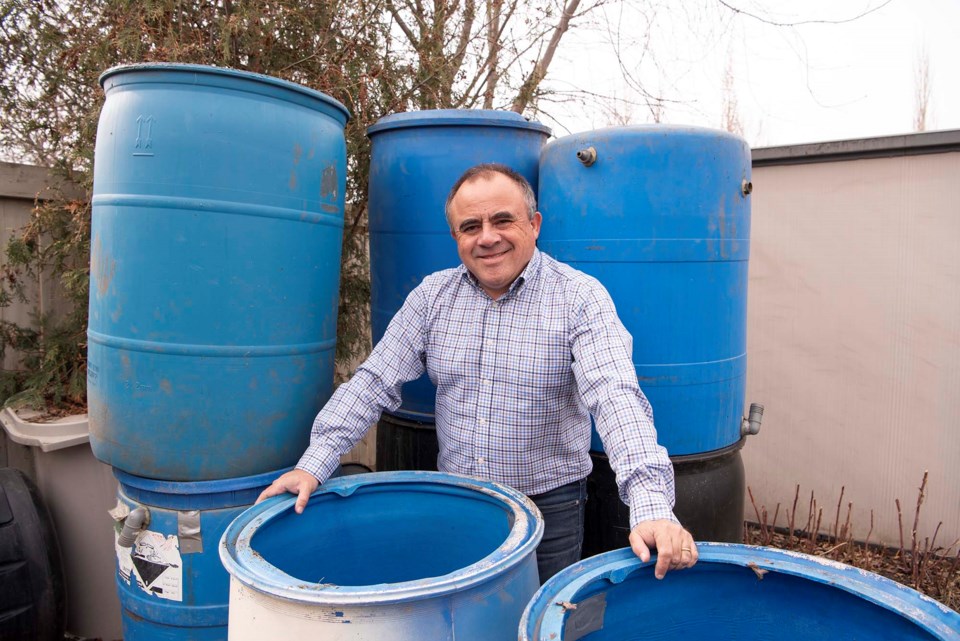How Now Green Cow
How Now Green Cow is examining how our dinners are shaping, and are being shaped by, the climate crisis. Got a food and climate question? Send it to [email protected] so it can be addressed in a future story.
St. Albert gardener Omar Nef is ready for this year’s drought.
Five years ago, the Erin Ridge gardener got a rain barrel for his backyard-sized garden just to try it out. Now, he has 15 of them daisy-chained together to his downspouts, waiting for the first rain of the season.
“One night of rain, it fills all my 15 bottles in one night and I have water for 10 to 15 days,” he said — enough to get him through all of last year’s dry spells.
Nef said his system has meant he hasn’t had to use tap water on his garden in five years, saving him money and leaving more water for other residents during dry times. On top of that, his vegetables are still going strong.
“Last year I had this one tomato that was 500 grams!” he said, with pride.
Drought defence
Global heating is bringing longer, hotter summers and more extreme weather such as drought to the Sturgeon County region, the county’s climate adaptation plan reports. Sturgeon County is projected to have ten times more heat waves by the 2060s (three per year compared to the current 0.3), which could trigger more wildfires, droughts, and thunderstorms.
Drought has been a hot topic amongst St. Albert gardeners in recent weeks, said Aida Mustapic, organic master gardener and founder of the St. Albert Backyard Gardening Facebook group.
“Some people are saying, ‘I don’t even know if I should plant a garden.’”
Water storage is one way to guard against drought. The Coal Mine Road Community Garden has a massive rainwater collection system designed by Nef that provides for all the garden’s needs, St. Albert Seed Library co-founder Dale Ford said in an email.
“Once we finally got rain last spring, we never ran out of water, even with those periods of over six weeks with no rain.”
The City of St. Albert promotes the use of rain barrels to save water, and will hold its annual rain barrel sale this May 4.
Water efficiency is another defence. Alberta greenhouse operators typically use drip irrigation and water-recycling systems to reuse 80-to-90 of their irrigation water, said Michiel Verheul, Sturgeon County farmer and president of the Alberta Greenhouse Growers Association. Some will add gel-like substances to their pots to hold onto more water.
Urban gardeners can create a cheap drip-irrigation system by poking holes in a garden hose, Mustapic said. You can also give your crops more water less often; instead of watering a tree every day, give it a lot of water twice a month to encourage root development.
You can also switch to water-efficient crops, Mustapic said. Native plants and perennials such as saskatoons and wild blueberries tend to be naturally drought-resistant due to their deep roots.
Build better dirt
Many drought defences involve building better soil.
Crop manager Steele Perrett doesn’t use giant rain barrels to catch water for crops at Lakeside Dairy in Sturgeon County, for example. Instead, he and his crews leave six-inch-tall stubble in the fields to catch winter snow and slow summer rains, giving both more time to seep into the soil. They use no-till farming to keep roots intact, creating water-catching channels into the ground, and protect wetlands to catch and trap water before it runs off. To reduce evaporation losses, he covers harvested fields with as much crop residue as possible — the fields look like they’re covered with burlap sacks when he’s done with them.
“Soil’s meant to be covered,” Perrett said — just check out the lush greenery along any country fence-line for proof.
“It doesn’t matter how we or dry it is, by that fence-line it’s always growing fantastically well.”
Mustapic said urban farmers can build drought-resistant soils by bulking them up with organic matter.
“Organic matter can hold ten times its weight in water,” she noted, so if you keep adding compost to your garden, you won’t have to water it as often. (You’ll also restore all the nutrients your vegetables have pulled out of it.)
Spreading mulch on your garden reduces water loss from evaporation and adds organic matter to your soil, Mustapic continued. You can use wood chips, but she recommended lawn clippings, as those are free.
Proper gardening practices can turn your garden into a carbon sink and reduce the impacts of global heating, Mustapic said.
“If we implement these steps over the next couple of years, our gardens will become naturally more resilient.”




